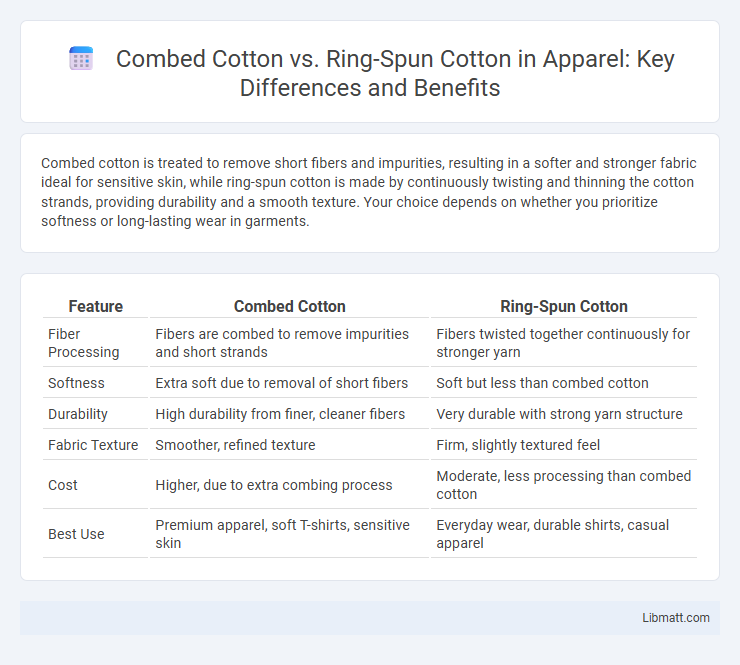Combed cotton is treated to remove short fibers and impurities, resulting in a softer and stronger fabric ideal for sensitive skin, while ring-spun cotton is made by continuously twisting and thinning the cotton strands, providing durability and a smooth texture. Your choice depends on whether you prioritize softness or long-lasting wear in garments.
Table of Comparison
| Feature | Combed Cotton | Ring-Spun Cotton |
|---|---|---|
| Fiber Processing | Fibers are combed to remove impurities and short strands | Fibers twisted together continuously for stronger yarn |
| Softness | Extra soft due to removal of short fibers | Soft but less than combed cotton |
| Durability | High durability from finer, cleaner fibers | Very durable with strong yarn structure |
| Fabric Texture | Smoother, refined texture | Firm, slightly textured feel |
| Cost | Higher, due to extra combing process | Moderate, less processing than combed cotton |
| Best Use | Premium apparel, soft T-shirts, sensitive skin | Everyday wear, durable shirts, casual apparel |
Introduction to Cotton Fabric Types
Combed cotton undergoes an extra processing step where fibers are carefully combed to remove short strands and impurities, resulting in a smoother, stronger fabric with enhanced softness and durability. Ring-spun cotton is produced by continuously twisting and thinning the cotton strands, which creates a finer, more compact yarn that offers increased strength and a softer texture compared to conventional cotton. Both fabrics are popular in high-quality apparel and textiles, with combed cotton excelling in softness and purity, while ring-spun cotton provides superior strength and fabric longevity.
What Is Combed Cotton?
Combed cotton is a superior type of cotton where fibers are carefully aligned and shorter strands removed to produce a smoother, stronger fabric. This process enhances durability and softness, making it ideal for premium clothing and textiles. Your garments made from combed cotton will feel more comfortable and resist pilling compared to regular cotton fabrics.
What Is Ring-Spun Cotton?
Ring-spun cotton is a type of cotton yarn made by twisting and thinning the cotton fibers to create a stronger, finer, and softer thread compared to regular cotton. The process involves continuously spinning and stretching the fibers, resulting in fabric that is more durable, breathable, and comfortable for garments. This method contrasts with combed cotton, where impurities and short fibers are removed before spinning, enhancing the smoothness but not necessarily the strength of the yarn.
Key Differences Between Combed and Ring-Spun Cotton
Combed cotton undergoes a special treatment that removes short fibers and impurities, resulting in a smoother, stronger fabric with fewer flaws. Ring-spun cotton is produced by twisting and thinning the cotton fibers, creating a finer, more durable yarn with a soft texture. While combed cotton emphasizes cleanliness and uniformity, ring-spun cotton highlights yarn strength and fabric softness, making each ideal for different high-quality textile applications.
Softness and Texture Comparison
Combed cotton undergoes a special treatment that removes short fibers and impurities, resulting in a smoother, softer texture ideal for sensitive skin. Ring-spun cotton, spun by twisting and thinning the cotton strands, produces a denser yarn that feels softer and more durable than standard cotton but slightly less smooth than combed cotton. Your choice between these two affects the fabric's softness and texture, with combed cotton offering a silkier touch and ring-spun cotton delivering a balanced softness with enhanced strength.
Durability and Longevity
Combed cotton undergoes a fine brushing process that removes short fibers and impurities, resulting in a fabric that is softer and more durable than regular cotton. Ring-spun cotton is produced by twisting and thinning cotton fibers to create a strong, dense thread, enhancing the fabric's overall strength and longevity. Both combed and ring-spun cotton fabrics offer superior durability, but ring-spun cotton typically provides a higher resistance to wear and tear over extended use.
Breathability and Comfort
Combed cotton offers superior breathability compared to ring-spun cotton due to its longer, finer fibers that allow better air circulation and moisture wicking. Ring-spun cotton, while softer and stronger from its tightly twisted fibers, can sometimes feel denser, slightly reducing breathability. Both types enhance comfort, but combed cotton is often preferred for lightweight, breathable garments ideal for warm weather.
Cost and Affordability
Combed cotton typically costs more than ring-spun cotton due to its additional processing steps that remove impurities and short fibers, resulting in a smoother and stronger fabric. Ring-spun cotton is generally more affordable, offering good durability and softness but with less refinement compared to combed cotton. Consumers seeking budget-friendly options often choose ring-spun cotton, while those prioritizing premium texture and longevity may invest in combed cotton despite the higher price.
Best Uses for Combed vs Ring-Spun Cotton
Combed cotton is ideal for premium-quality garments, offering superior softness and durability, making it perfect for luxury t-shirts, bedding, and baby clothes. Ring-spun cotton provides a stronger, finer yarn that enhances fabric strength and breathability, suitable for everyday wear and athletic apparel. You should choose combed cotton for softness and luxury, while ring-spun cotton excels in durability and comfort for active lifestyles.
Choosing the Right Cotton for Your Needs
Combed cotton undergoes extra processing to remove short fibers and impurities, resulting in a softer, stronger, and higher-quality fabric ideal for sensitive skin or luxury garments. Ring-spun cotton is created by twisting and thinning the cotton strands, producing a durable and fine yarn suitable for everyday wear and long-lasting clothing. Selecting between combed and ring-spun cotton depends on whether you prioritize softness and premium feel or durability and cost-effectiveness for your specific textile application.
Combed cotton vs ring-spun cotton Infographic

 libmatt.com
libmatt.com